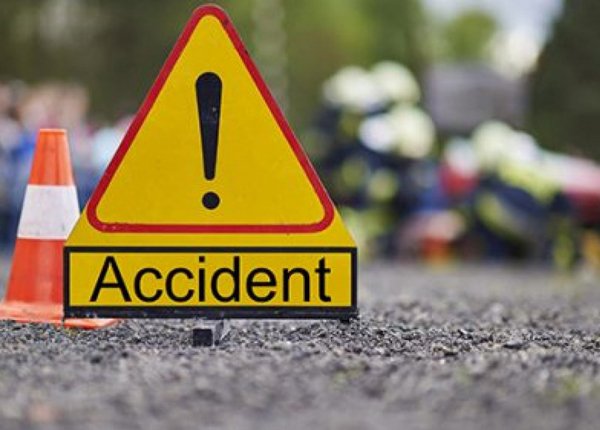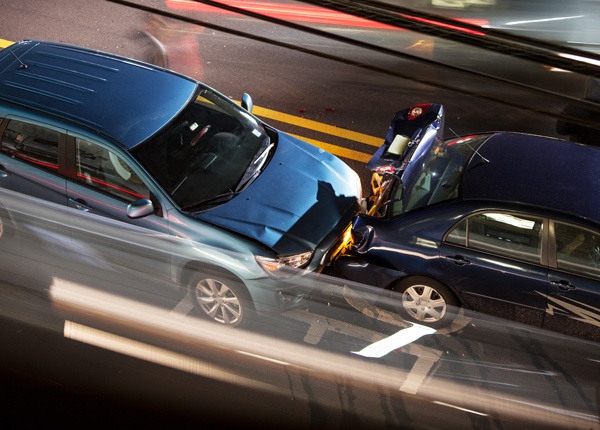
Understanding, Avoiding and Dealing with Collisions & Traffic Accidents
Updated Dec. 25, 2020Unfortunately, traffic accidents and collisions are an inevitable part of being a driver. While driving attentively and defensively will dramatically limit your chances of being involved in a collision, nobody makes perfect driving decisions all the time. It is human nature to make mistakes, so even if you manage to avoid serious property damage or injury during your time as a motorist, it is likely that you will at least experience a fender-bender or some sort of minor collision. In the following section, we’ll teach you how to evade and minimize the severity of different types of traffic collisions. Plus, we detail everything you need to know about your legal obligations following any collision you are involved in.
Before we begin, let’s recap the key information covered in the previous section, concerning the science of driving. You do not need to be an astrophysicist to understand how the forces of nature determine the outcome of a traffic collision. Though, having a basic understanding of these laws will help you to predict how a crash will play out and make the right decisions to keep yourself safe.
Momentum and inertia
Your car and all the occupants riding within it have momentum. In physics, momentum is defined as “quantity of motion” and is calculated using mass and speed. The more momentum a moving object has, the harder it is to slow down and stop. Traffic collisions involving vehicles with a lot of momentum are generally more severe, as greater momentum leads to a greater force of impact.
Inertia is a term that describes a moving object’s unwillingness to change direction or speed. According to inertia, an object in motion can only be sped up, slowed down or moved from its current course if a force acts upon it to give it “new instructions”. Where your vehicle is concerned, this force may be friction applied by the brakes, or the force of the steering wheel turning to redirect the wheels. The more momentum an object has, the more resistant it is to outside forces.
It is important to understand the concept of inertia as it relates to car crashes and collisions. While in a moving car, your body will be traveling at the same speed as the vehicle. If the car collides with an object and suddenly stops or slows down, inertia will cause your body to continue moving forward at its original speed until the force of impact with another object stops it. If you have buckled up, this “object” will be the straps of your seat belt. If not, it may be the steering wheel, dashboard, windscreen or something outside the car. Remember, seat belts save lives.
Kinetic energy
Kinetic energy is the energy your vehicle generates from movement. For the car to stop, all its kinetic energy must dissipate. Under normal conditions when you slow down or stop, the vehicle’s brakes will absorb this energy. If the car collides with an object before all its energy has been absorbed, that energy will be released instantly in the force of impact. Greater energy leads to greater force and usually, a more destructive collision.
As a driver, it is important to understand how your vehicle’s energy is determined. It increases with the weight of the vehicle and with the speed of the vehicle squared. This means that a collision at 75mph has nine times the force of impact of a collision at 25mph. Limiting your speed is by far the best tactic you can employ to avoid and reduce the severity of collisions.
Impulse
Impulses occur when your vehicle exerts energy to speed up, or energy is absorbed when it slows down. Sudden energy absorption or expenditure results in a more powerful impulse. You will be able to feel the impulse as a jolt through the vehicle when you brake or accelerate suddenly while driving. When you slow down or speed up gradually, the impulse you feel will be much gentler. The force of an impulse also increases the more energy an object has. As we know, the energy of your vehicle increases exponentially with its speed.
Stopping or slowing down suddenly when traveling at a high speed can result in a deadly impulse, leading to crushed bones, ruptured internal organs and other devastating injuries. Most modern vehicles are built with safety features like airbags and crumple zones which are designed to slow energy release on impact and lessen the severity of the impulse. These measures reduce impact force in head-on and rear collisions; if a vehicle strikes the side of a passenger compartment where no cushioning safety measures are in place, the occupants can be seriously injured.
Centrifugal and centripetal forces
When you drive through a curved stretch of roadway, inertia will create a centrifugal force that encourages your vehicle to continue traveling in a straight line, pulling it away from the direction you are steering. The force exerted by the friction between your wheels and the roadway pulling you toward the curve is known as centripetal force. These two forces must be balanced if you are to remain in your lane as you drive through a curve.
If an imbalance leads the centripetal force to win out, your car will turn too much as you move through the curve. More commonly in driving, centrifugal force becomes overpowering and prevents the vehicle from turning enough, leading it to leave the lane and drive off the edge of the roadway. The biggest contributing factor in these incidents is speed. The faster your vehicle moves through the curve, the harder it is to overcome inertia.
Understanding traffic collisions
Car crashes can usually be categorized as head-on, rear-end, side-impact, roll-over or single-vehicle collisions. These labels refer to the point of impact between two objects or the way in which the collision occurs. Most traffic collisions fit at least two of these definitions, for instance:
- A vehicle driving directly into the side of another vehicle would qualify as side-impact AND head-on.
- A vehicle rolling over on a bend and colliding with a stationary object off the roadside qualifies as single-vehicle AND involves roll-over.
In each of these collision types, momentum, energy, inertia, impulse and force play different roles. As a result, some types of traffic collisions are usually more severe than others. The way different collisions typically play out is discussed in full in the next module, following this introduction.
This is essential knowledge for motorists to have. Most unavoidable collisions have several possible outcomes. When you know which outcome is the most likely to result in death or serious injury, you can take action to direct your vehicle into a less destructive situation.
What causes collisions?
Answering this question is the first step towards being able to avoid traffic collisions altogether. All new motorists must be taught how to respond and drive evasively during an emergency, to lessen the severity of collisions. Though, in the battle against loss of life, learning how to prevent collisions in the first place is more important. The fact is that most collisions could be avoided if the drivers involved made better decisions. Research has shown us that driver-error is by far the biggest killer on our nation’s roads.
Understanding driver-error is important as it does not only refer to deliberate acts of dangerous driving. Also included under the driver-error umbrella are:
Most motorists believe that they are good, responsible drivers. Unless you actively keep tabs on your behavior behind the wheel, the sad truth is that you are probably committing at least one of these driver-errors on a regular basis. Learn more about what causes traffic accidents and collisions.
Dealing with driving emergencies
So, what should you do if you find yourself at risk of being involved in a collision on the road? Well, there is a great deal you can do to avoid a crash – even one that seems imminent! The action you take should depend on the type of collision you are threatened with. Even if you cannot avoid the incident altogether, you can probably reduce the severity of the impact and walk away unscathed. Based on whether you are faced with a head-on, rear-end or side-impact collision, this module will explain the last-minute tactics you can employ to avoid a crash or lessen the force of impact.
We also cover vital traction control techniques that can help you maintain your grip on the road’s surface and control over the vehicle while making evasive maneuvers. The basic rule to remember in emergency situations is that acting in a controlled manner is key. Slamming your foot down on the brake or jerking the steering wheel sharply will imbalance your vehicle and lead to loss of traction, making an already hazardous situation far worse.
When a collision occurs
Despite your best efforts, you may one day be involved in a traffic accident or collision. While all drivers must do their utmost to avoid these incidents, they must also be prepared for all eventualities and know what to do when a collision occurs. There are strict laws governing post-collision protocol for the parties involved, in every state in America. The penalties incurred for breaking these laws do vary from one state to the next. We have included some general guidelines in this module to give you an idea of what to expect should you fail to fulfill your legal obligations. Though, you should also check your state’s driving manual for local information.
The number-one rule for any driver involved in a traffic collision is: move over and stop. You are legally required to make yourself known to other parties involved, aid any injured persons and exchange details, before leaving the scene. If you drive away from the scene of a collision without fulfilling these basic responsibilities, you will be charged with a hit-and-run.
Whether the police need to be called to the site of the accident will depend on the severity of the incident. If no person is injured and all vehicles involved can be driven safely, it may not be necessary to have a police officer attend the scene. Though, if any property damage or injury has been sustained, it is ALWAYS necessary to report the incident to the police at the earliest opportunity. You will need a police report in order to get damages covered by your insurance company.
Following collisions where it is not immediately obvious who is at fault, you should take the time to write down as much information as possible at the scene. Make sure you have the names and addresses of everybody involved, a note of any relevant weather and roadway conditions and a brief description of how the collision occurred. Having the presence of mind to gather this information at the time of the incident will save you a lot of stress later!
It could happen to you
Nobody likes to entertain the possibility of being involved in a crash or collision - particularly when first learning to drive! Learning how to deal with collisions is a frightening but vital aspect of your driver’s training. As motorists, we cannot ignore the fact that collisions happen every day, in every city and state. More importantly, they could happen to anybody. You could be the safest driver in the world and still fall victim to the foolish actions of another road user. Therefore, you must be ready and armed with the right knowledge to deal with dangerous situations and crashes effectively.
Your safety on the road is largely within your control. Even if you cannot avoid a collision, you absolutely can influence the way that collision plays out. The techniques covered in this essential section will teach you how to turn a potentially devastating crash into a minor collision – or as close to it as possible. Let’s begin, with an analysis of severity in different types of collisions.




